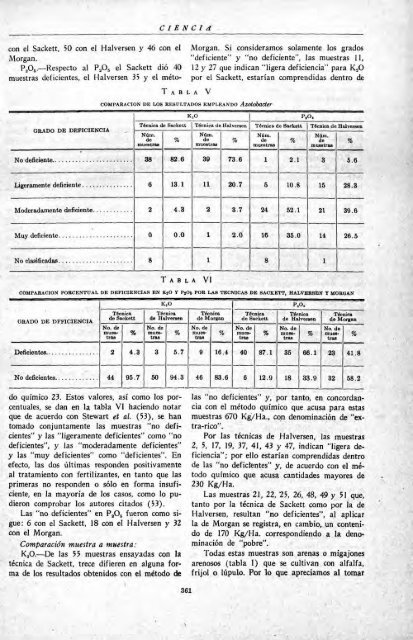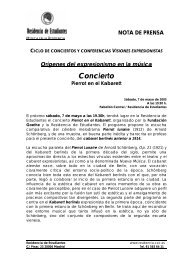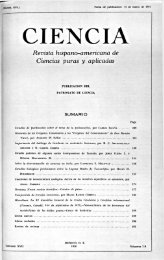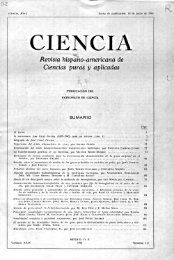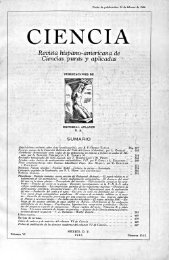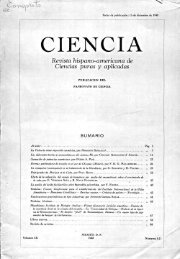Números 10-12 - Consejo Superior de Investigaciones Científicas
Números 10-12 - Consejo Superior de Investigaciones Científicas
Números 10-12 - Consejo Superior de Investigaciones Científicas
You also want an ePaper? Increase the reach of your titles
YUMPU automatically turns print PDFs into web optimized ePapers that Google loves.
CIENCIA<br />
con el Sackett, 50 con el Halversen y 46 con el Morgan. Si consi<strong>de</strong>ramos solamente los grados<br />
Morgan. "<strong>de</strong>ficiente" y "no <strong>de</strong>ficiente'*, las muestras II,<br />
p 20 5.—Respecto al P 2O e el Sackett dio 40 <strong>12</strong> y 27 que indican "ligera <strong>de</strong>ficiencia" para K 20<br />
muestras <strong>de</strong>ficientes, el Halversen 35 y el meto- por el Sackett, estarían comprendidas <strong>de</strong>ntro <strong>de</strong><br />
ORADO DE DEFICIENCIA<br />
T A B L A V<br />
COMPARACIÓN DE LOS RESULTADOS EMPLEANDO Azotobacter<br />
K aO<br />
Técnica <strong>de</strong> Sackett Técnica <strong>de</strong> Halversen Técnica <strong>de</strong> Sackett Técnica <strong>de</strong> Halversen<br />
Núm.<br />
<strong>de</strong><br />
muestras<br />
%<br />
Núm.<br />
<strong>de</strong><br />
muestras<br />
%<br />
Núm.<br />
<strong>de</strong><br />
muestras<br />
%<br />
Núm.<br />
<strong>de</strong><br />
muestras<br />
38 82.6 39 73.6 1 2.1 3 5.6<br />
6 13.1 11 20.7 6 <strong>10</strong>.8 15 28.3<br />
Mo<strong>de</strong>radamente <strong>de</strong>ficiente 2 4.3 2 3.7 24 52.1 21 39.6<br />
0 0.0 1 2.0 16 35.0 14 26.5<br />
8 1 1<br />
T A B L A VI<br />
COMPARACIÓN PORCENTUAL DE DEFICIENCIAS EN KjO Y PjOs POR LAS TÉCNICAS DE SACKETT, HALVERSEN Y MORGAN<br />
ORADO DE DFFICIENCIA<br />
Ten nica<br />
<strong>de</strong> Sackett<br />
No. <strong>de</strong><br />
muestras<br />
%<br />
K aO F,O ft<br />
Técnica<br />
<strong>de</strong> Halversen<br />
No. <strong>de</strong><br />
muestras<br />
do químico 23. Estos valores, así como los por<br />
centuales, se dan en la tabla VI haciendo notar<br />
que <strong>de</strong> acuerdo con Stewart et al. (53), se han<br />
tomado conjuntamente las muestras "no <strong>de</strong>fi<br />
cientes" y las "ligeramente <strong>de</strong>ficientes" como "no<br />
<strong>de</strong>ficientes", y las "mo<strong>de</strong>radamente <strong>de</strong>ficientes"<br />
y las "muy <strong>de</strong>ficientes" como "<strong>de</strong>ficientes". En<br />
efecto, las dos últimas respon<strong>de</strong>n positivamente<br />
al tratamiento con fertilizantes, en tanto que las<br />
primeras no respon<strong>de</strong>n o sólo en forma insufi<br />
ciente, en la mayoría <strong>de</strong> los casos, como lo pu<br />
dieron comprobar los autores citados (53).<br />
Las "no <strong>de</strong>ficientes" en P a0 6 fueron como si<br />
gue: 6 con el Sackett, 18 con el Halversen y 32<br />
con el Morgan.<br />
Comparación muestra a muestra:<br />
K 20.—De las 55 muestras ensayadas con la<br />
técnica <strong>de</strong> Sackett, trece difieren en alguna for<br />
ma <strong>de</strong> los resultados obtenidos con el método <strong>de</strong><br />
%<br />
Técnica<br />
<strong>de</strong> Monean<br />
No. <strong>de</strong><br />
muestras<br />
% No. <strong>de</strong><br />
muestras<br />
Técnica<br />
<strong>de</strong> Sackett<br />
%<br />
Técnica<br />
<strong>de</strong> Halversen<br />
No. <strong>de</strong><br />
muestras<br />
%<br />
% ;<br />
Técnica<br />
<strong>de</strong> Morgan<br />
No. <strong>de</strong><br />
muestras<br />
2 4.3 3 5.7 9 16.4 40 87.1 35 66.1 23 41.8<br />
44 95.7 50 94.3 46 83.6 6 <strong>12</strong>.9 18 33.9 32 58.2<br />
361<br />
las "no <strong>de</strong>ficientes" y, por tanto, en concordan<br />
cia con el método químico que acusa para estas<br />
muestras 670 Kg/Ha., con <strong>de</strong>nominación <strong>de</strong> "ex<br />
tra-rico".<br />
Por las técnicas <strong>de</strong> Halversen, las muestras<br />
2, 5, 17, 19, 37, 41, 43 y 47, indican "ligera <strong>de</strong><br />
ficiencia"; por ello estarían comprendidas <strong>de</strong>ntro<br />
<strong>de</strong> las "no <strong>de</strong>ficientes" y, <strong>de</strong> acuerdo con el mé<br />
todo químico que acusa cantida<strong>de</strong>s mayores <strong>de</strong><br />
230 Kg/Ha.<br />
Las muestras 21, 22, 25, 26, 48, 49 y 51 que,<br />
tanto por la técnica <strong>de</strong> Sackett como por la <strong>de</strong><br />
Halversen, resultan "no <strong>de</strong>ficientes", al aplicar<br />
la <strong>de</strong> Morgan se registra, en cambio, un conteni<br />
do <strong>de</strong> 170 Kg/Ha. correspondiendo a la <strong>de</strong>no<br />
minación <strong>de</strong> "pobre".<br />
Todas estas muestras son arenas o migajones<br />
arenosos (tabla 1) que se cultivan con alfalfa,<br />
frijol o lúpulo. Por lo que apreciamos al tomar<br />
%


